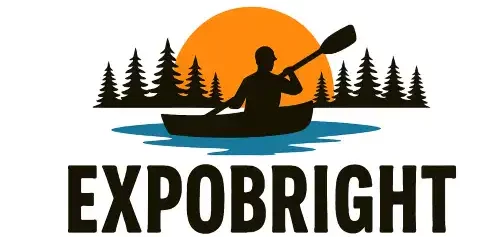Where to kayak camp near me is the question that ignites countless evening conversations around campfires and paddling shop counters. The burning desire to escape into nature with nothing but a kayak and essential gear drives paddlers to seek out those perfect overnight spots accessible only by water. Yet finding these hidden gems requires more than just good intentions and a sense of adventure.
Last spring, I helped a family from Michigan discover their first kayak camping destination using the exact techniques I’ll share here. Within two weeks, they were paddling through a cypress swamp in Florida, their kids spotting alligators from the safety of their tandem kayak. The transformation from uncertain beginners to confident kayak campers happened because they learned where and how to look.
Must read for your safety when kayak camping: How to get rid of spider in a kayak?
Where to kayak camp near me?
The best kayak camping spots near you exist within a surprisingly accessible network of federal, state, and local waterways that offer designated camping areas specifically designed for paddle-in access. Most paddlers don’t realize that over 48,000 canoeing and kayaking locations exist across North America, with thousands offering camping opportunities ranging from primitive wilderness sites to established campgrounds with amenities.
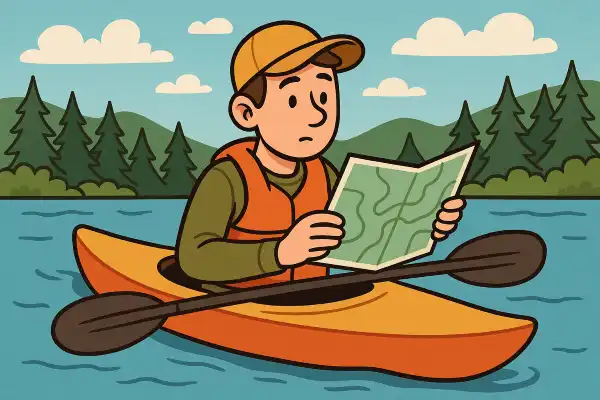
Start with apps
Recreation.gov serves as your primary gateway to federal camping locations, with their mobile app providing on-the-go access to thousands of camping destinations that you can search by location, amenities, and availability. Download this essential tool first—it covers national forests, national parks, and Bureau of Land Management areas where many pristine kayak camping opportunities exist.
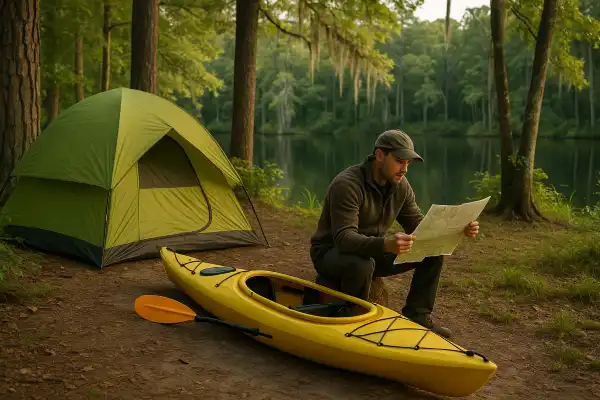
Paddling.com offers the most comprehensive database with over 22,000 launch sites and destinations, allowing you to research paddling routes and identify potential camping areas. Their interactive maps help you plan complete trips from put-in to take-out, with user reviews providing real-world insights about site conditions and accessibility.
State park websites have evolved into sophisticated park finder tools. States like South Carolina offer interactive maps with filters for specific activities like kayaking and camping, while Texas Parks & Wildlife provides detailed search functions that let you narrow down options by water access and camping type.
Explore your state and regional park systems
Each state maintains its own network of parks with water access camping. Illinois alone offers dozens of locations like Castle Rock State Park, which features primitive canoe-in campgrounds along the Rock River. These state-managed locations often provide the perfect balance of wilderness experience and basic safety infrastructure.
Regional county parks frequently offer hidden treasures that avoid the crowds of major destinations. Kayak Point Regional County Park in Washington exemplifies this perfectly, providing year-round camping with 30 partial-utility sites and yurt options, plus 3,300 feet of shoreline access. County parks typically cost less than state or federal alternatives while maintaining excellent facilities.
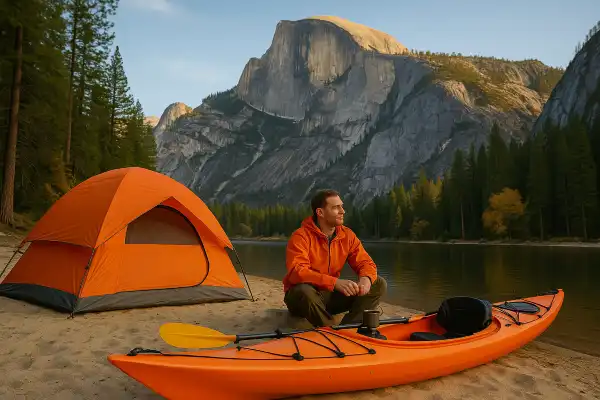
Contact your state’s Department of Natural Resources directly. Their staff members possess intimate knowledge of lesser-known locations and can recommend sites based on your skill level and preferred camping style. Many states publish annual paddling guides with detailed maps showing camping locations, portage points, and difficulty ratings.
Some places to consider
1. Boundary Waters canoe area wilderness, Minnesota
The Boundary Waters spans over 1 million acres along the U.S.-Canada border, featuring more than 1,200 miles of canoe routes and over 2,000 designated campsites. This pristine wilderness allows no motorized vehicles, creating an authentic backcountry experience where only the sounds of loons and crackling campfires break the silence. Each campsite includes a fire grate, latrine, and tent pads, positioned strategically on rocky points and secluded bays.
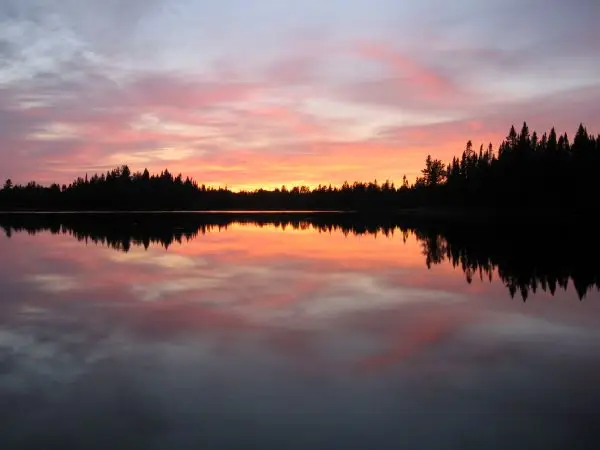
Permits are required from May 1 to September 30 for overnight visits, and the quota system limits daily entries to preserve the wilderness character. The interconnected lakes require portaging between waterways, making this destination ideal for paddlers seeking both challenge and solitude. Wildlife encounters with moose, black bears, and bald eagles happen regularly, while northern lights displays illuminate the designated Dark Sky Sanctuary during clear evenings.
2. Everglades National Park, Florida
The 99-mile Wilderness Waterway runs from the Gulf Coast Visitor Center to Flamingo, passing through the most remote region of the United States east of the Mississippi. Backcountry camping requires permits obtainable only 24 hours in advance on a first-come, first-served basis from either visitor center. The winter season (late November through early April) requires fees, while summer permits are free.

Elevated chickees (wooden platforms) and ground sites dot the waterway, providing refuge in this vast subtropical wilderness. Navigation demands map and compass skills as GPS signals often fail among the endless mangrove tunnels. Raccoons visit campsites nightly, requiring hardshell protection for all food and water supplies. Alligators, manatees, dolphins, and over 350 bird species make this ecosystem unparalleled for wildlife observation. The challenging conditions and remoteness make this destination suitable only for experienced kayak campers.
3. Lake Powell, Utah/Arizona
Lake Powell offers secluded beach camping within paddling distance of Antelope Canyon’s entrance, making it perfect for combining water sports with slot canyon exploration. The deep, cliff-lined canyon acts like a wind tunnel, creating unpredictable conditions that require constant weather awareness. Dispersed camping is permitted on beaches above the high-water mark, allowing you to claim your own private stretch of red rock coastline.
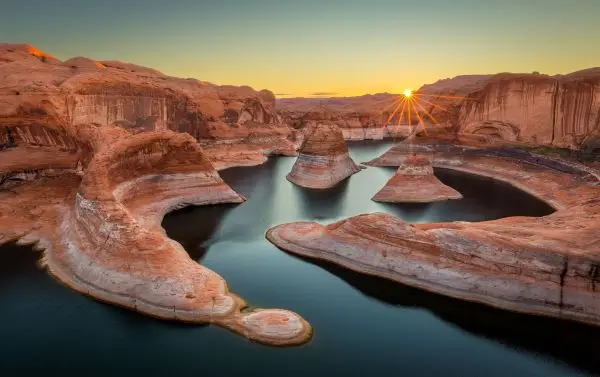
The lake provides excellent kayaking opportunities to experience magnificent geologic wonders, from towering sandstone cliffs to hidden side canyons accessible only by water. Rocky beaches offer sheltered camping spots protected from wind, while the crystal-clear water provides excellent swimming and fishing. The vast reservoir’s 2,000 miles of shoreline ensure solitude even during busy seasons. Antelope Point Launch Ramp provides convenient access for multi-day adventures exploring this engineering marvel amid some of America’s most spectacular desert scenery.
4. Buffalo National River, Arkansas
America’s first National River flows freely for 135 miles as one of the few remaining undammed rivers in the lower 48 states. Campgrounds range from primitive sites with vault toilets to developed areas with electric and water hookups. The upper Buffalo offers the most dramatic scenery, including towering bluffs and the spectacular Big Bluff formation.

Multi-day trips from Ponca to Woolum showcase the river’s prettiest sections, while primitive camping allows you to choose your own riverside spots. The park charges no entry fee, only camping fees, making it an affordable destination for extended trips. Spring provides the best water levels and wildflower displays, while fall offers stunning foliage and comfortable temperatures. Steel Creek and Ponca serve as primary launch points when water levels permit. The Ozark Mountains setting provides excellent hiking opportunities from riverside camps, with historic homesteads and waterfalls accessible via short trails.
5. Prince William Sound, Alaska
Prince William Sound surrounds paddlers with towering glaciers and frequent orca encounters, creating Alaska’s premier coastal kayaking experience. Sixteen rustic Forest Service cabins offer respite during extended journeys through the Chugach National Forest. Cabin reservations through Recreation.gov provide heated shelter with bunks, wood stoves, and basic cooking facilities, eliminating the need for tents in this challenging environment.

Tidewater glaciers calve icebergs directly into paddling routes, requiring careful navigation and weather monitoring. Sea otters, seals, humpback whales, and stellar sea lions frequent these protected waters, while bald eagles nest on countless islands. The sound’s complex geography includes protected fjords, exposed coastal sections, and countless secluded beaches for wilderness camping. Float plane access from Anchorage or Cordova puts you into the heart of this pristine marine ecosystem, where camping under the midnight sun creates unforgettable memories amid some of Earth’s most spectacular coastal wilderness.
6. San Juan Islands, Washington
Located near the U.S.-Canada border, this island chain provides year-round orca whale encounters plus regular sightings of sea lions, seals, dolphins, and otters. Washington State Parks maintains several marine campsites accessible only by kayak, including sites on Jones Island, Stuart Island, and Sucia Island. Each marine park offers composting toilets, picnic tables, and fire rings, with some featuring freshwater sources.
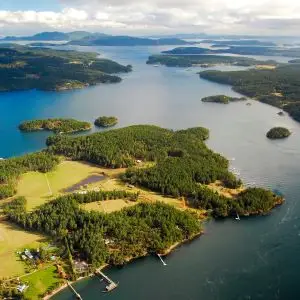
The protected waters between islands create ideal conditions for beginning sea kayakers, while outer coastlines challenge experienced paddlers with tidal currents and wind exposure. Multi-day trips allow exploration of smaller islands off Lopez Island and paddling through protected waters around Orcas Island. Ferry access from Anacortes provides convenient vehicle transport, while local outfitters offer gear rentals and guided trips. The temperate marine climate extends the paddling season year-round, though summer provides the most reliable weather for camping. Reservations are essential during peak season for the limited marine campsite spaces.
7. Pictured Rocks National Lakeshore, Michigan
Multi-colored sandstone cliffs rise 200 feet above Lake Superior, creating one of the Great Lakes’ most spectacular kayaking destinations, where camping requires advance reservations at designated backcountry sites. Chapel Beach and Twelvemile Beach offer rustic camping spots for $25 per night, positioned along the 42-mile shoreline of towering cliffs, waterfalls, and sea caves. The cold, clear waters of Lake Superior demand proper exposure protection and weather awareness, as conditions can change rapidly from calm to dangerous.
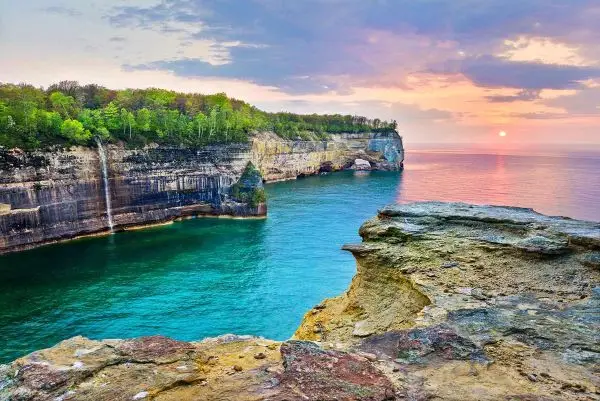
Kayak access allows intimate exploration of arches, caves, and waterfalls invisible from land-based viewpoints. Day trips from Munising provide access to shorter sections, while committed paddlers tackle the full shoreline over multiple days. Summer provides the warmest conditions, though fog and sudden storms require constant vigilance. The combination of pristine Great Lakes wilderness and dramatic geology makes this destination unique among North American paddle-camping opportunities. Black bears occasionally visit campsites, requiring proper food storage protocols.
8. Voyageurs National Park, Minnesota
This remote park along the Ontario border contains 84,000 acres of water, 655 miles of undeveloped shoreline, and over 500 islands. All 270 campsites require canoe or boat access and must be reserved in advance, creating an exclusively water-based camping experience in one of America’s most pristine lake country destinations.
Four large lakes—Rainy, Kabetogama, Namakan, and Sand Point—connect through narrow channels and portages used by voyageurs for centuries. Each campsite includes a fire ring, picnic table, and vault toilet, with tent pads carved from the Canadian Shield granite. The park’s vast size ensures solitude even during peak summer months, while spring and fall offer spectacular migrations and changing foliage. Winter transforms the landscape for ski-camping adventures across frozen lakes. Historical significance adds depth to the wilderness experience, with pictographs, logging artifacts, and old-growth forests preserving the region’s rich cultural heritage. The international boundary setting provides unique cross-border paddling opportunities into Ontario’s Quetico Provincial Park.
9. Lake Chelan, Washington
This 50-mile lake stretches through the North Cascades from the picturesque town of Chelan, offering 25 shoreline campsites and access to the Lake Chelan-Sawtooth Wilderness. The lake’s unique geography creates a natural corridor through the Cascade Range, with campsite elevations ranging from lakeshore to alpine settings. Stehekin, accessible only by boat, plane, or foot, provides a unique resupply point and lodging option at the lake’s remote upper end.
The Lady of the Lake passenger ferry operates year-round, allowing kayakers to ride uphill and paddle back to civilization. Crystal-clear water averaging 400 feet deep maintains consistent cool temperatures perfect for summer camping. Dispersed camping opportunities exist in the surrounding national forest lands, while established campgrounds provide developed facilities. The area’s diverse ecosystems range from desert sagebrush at the lake’s lower end to alpine meadows and glaciated peaks near Stehekin. Fall offers spectacular larch displays, while summer provides the most reliable weather for extended camping trips.
10. Middle Fork Salmon River, Idaho
This bucket-list destination features serious Class III and IV rapids combined with superior fly fishing opportunities, creating the ultimate wilderness river experience in Idaho’s Frank Church-River of No Return Wilderness. Permits are required through a lottery system during busy summer months, reflecting the river’s popularity among experienced whitewater paddlers.
Designated campsites line the 100-mile route from Boundary Creek to Cache Bar, each featuring fire rings, camp tables, and riverside access. The Middle Fork flows through one of America’s largest wilderness areas, ensuring pristine conditions and abundant wildlife including bighorn sheep, mountain goats, and black bears. Natural hot springs provide luxurious soaking opportunities after challenging paddling days. The remote setting requires complete self-sufficiency for multi-day trips, typically lasting 4-6 days. Technical rapids demand advanced whitewater skills, making this destination suitable only for expert kayakers. The combination of wilderness solitude, world-class fishing, and challenging whitewater creates the ultimate river-camping adventure.
11. Green River, Utah
The Green River below Flaming Gorge National Recreation Area features rugged scenery and cold, clear water, offering world-class trout fishing in a spectacular red rock canyon setting. Gates of Lodore provides the classic multi-day experience through Dinosaur National Monument, with designated river camps spaced throughout the canyon. The river’s dam-controlled flows create consistent water levels and excellent camping beaches, while towering canyon walls provide shelter from wind.
Petroglyphs, pioneer inscriptions, and geological formations add educational value to the wilderness experience. The cold water temperatures require proper thermal protection year-round, while sudden weather changes demand careful preparation. Rapids range from gentle riffles to challenging Class III sections, making the Green suitable for intermediate to advanced paddlers. Multi-day permits through the National Park Service limit group sizes and camping locations. The river’s isolation creates an authentic frontier experience, with night skies free from light pollution and wildlife encounters including river otters, bighorn sheep, and golden eagles.
12. Allagash Wilderness Waterway, Maine
This pristine waterway flows through an expansive, underdeveloped region featuring moose, bears, and blueberries along the route. The full trip from Churchill Dam to Allagash Village includes Class II rapids, pristine lakes, and a mandatory portage around spectacular Allagash Falls. Registration is required before launching, and camping fees apply at designated sites maintained by the Maine Bureau of Parks and Lands. The 92-mile waterway preserves a corridor of virgin forest in northern Maine, providing habitat for moose, black bears, and loons.
Traditional wooden lean-tos shelter campers from weather while maintaining the historical character of this legendary paddling route. The Allagash represents the ultimate North Woods experience, with pristine lakes connected by river sections through dense spruce-fir forests. Fall foliage creates spectacular displays, while summer offers warm days and cool nights perfect for campfire gatherings. The waterway’s protected status ensures future generations will experience the same wilderness conditions that have attracted paddlers for over a century.
13. Wambaw Creek Wilderness, South Carolina
Located north of Charleston, this wilderness canoe trail features majestic cypress-tupelo stands and abundant wildlife. The creek is tidal, running about three hours later than Charleston, requiring careful timing for optimal paddling conditions. Francis Marion National Forest maintains primitive camping areas accessible by paddle, offering a rare lowcountry wilderness experience.
Ancient cypress trees draped in Spanish moss create cathedral-like paddling corridors through this pristine swamp ecosystem. Wildlife includes alligators, river otters, wood ducks, and numerous wading birds that thrive in the protected wetlands. The tidal influence creates ever-changing water levels and currents, demanding flexible trip planning and local knowledge. The trail provides access to one of the Southeast’s most intact bottomland hardwood forests, where camping among 500-year-old trees creates an unforgettable experience. Spring migration brings incredible bird diversity, while fall offers comfortable temperatures and stunning foliage. The proximity to Charleston allows easy access to supplies while maintaining true wilderness character within the extensive national forest system.
14. Apostle Islands National Lakeshore, Wisconsin
The Apostle Islands archipelago in Lake Superior offers 21 islands with designated camping areas accessible only by kayak or sailboat. Stockton Island provides the largest camping area with 19 sites, while smaller islands like Oak Island offer intimate settings with just a few sites each. Cold Lake Superior waters demand proper thermal protection and weather awareness, as conditions change rapidly from calm to dangerous. Sea caves, sandstone cliffs, and pristine beaches create diverse camping environments throughout the archipelago.
Historic lighthouses on several islands provide unique camping opportunities with guided tours and interpretive programs. The islands’ isolation ensures pristine conditions with minimal human impact, while excellent fishing opportunities include lake trout, salmon, and whitefish. Reservations are required for all island camping from May through October, with sites featuring fire rings, picnic tables, and vault toilets. The combination of maritime wilderness, cultural history, and Great Lakes beauty makes the Apostles a premier destination for adventure-seeking kayak campers.
15. Cache River, Illinois
The Lower Cache River Trail offers paddlers a 3-6 mile journey through magnificent cypress-tupelo swamp, providing access to one of Illinois’s most unique ecosystems. This ancient bottomland forest preserves the last remnant of swampland that once covered much of southern Illinois, where 1,000-year-old cypress trees tower above dark tannin-stained waters. Primitive camping opportunities exist in Shawnee National Forest lands adjacent to the river, offering a rare opportunity to camp within driving distance of major Midwest cities.
The Cache River system supports over 100 fish species and provides critical habitat for numerous rare and endangered species. Spring flooding creates spectacular wildlife viewing opportunities, while fall colors reflect beautifully in the still waters. The quality canoe and kayak experience reveals wildlife viewing opportunities through this pristine swamp environment. Navigation requires basic map skills as the meandering waterway creates numerous side channels and backwater areas. The region’s rich natural history includes Native American archaeological sites and remnants of early logging operations that shaped this landscape.
16. Tomoka State Park, Florida
Located in Northeast Florida, Tomoka State Park excels at kayak camping with excellent canoeing, kayaking, and boating opportunities combined with outstanding fishing. Over 160 bird species have been identified in the park, making it a paradise for birdwatchers. The park offers 100 camping spots near the Tomoka River, each equipped with a barbecue, picnic table, water, electric connection, and access to restrooms with hot showers. Both primitive and full-facility sites accommodate different camping preferences, while the park store rents kayaks for visitors without their own equipment.
The Tomoka River provides calm water perfect for beginning paddlers, while more adventurous kayakers can explore tidal creeks and saltwater marshes. Manatees frequently visit the warm waters during winter months, creating magical wildlife encounters. Archaeological sites preserve evidence of the Timucuan Indians who first inhabited this area, adding cultural significance to the natural experience. The park’s location between Daytona Beach and St. Augustine provides easy access to additional attractions and supply opportunities.
17. Brunet Island State Park, Wisconsin
The Fisher and Chippewa rivers meet at Brunet Island State Park in Northwestern Wisconsin, creating beautiful scenery and varied kayak camping activities. Brunet Island provides the ideal destination for paddlers seeking both fun and challenge, with about four miles of water separating Cornell from Holcombe Dam. The north campground features most sites positioned on or near the Chippewa River’s shoreline or bay, making it perfect for kayak camping.
Sixty campsites provide picnic tables, fire rings, and running water access, while shower facilities and flush toilets add comfort to the wilderness experience. The park office assists with kayak rentals from local vendors, making the destination accessible for visitors without their own equipment. Paddling, hiking, and wildlife viewing combine to create a complete outdoor experience. The river confluence creates diverse aquatic habitats supporting excellent fishing for walleye, smallmouth bass, and musky. Fall colors reflected in the quiet waters create spectacular photography opportunities, while summer provides warm conditions perfect for swimming and water sports.
18. Koreshan State Park, Florida
Located near the Estero River, Koreshan State Park provides 60 campsites, each featuring a picnic table, fire ring, and access to running water. The stunning scenery along the Estero River highlights the paddling experience, where spotting turtles on rocks, birds in oak trees, and occasional alligators creates memorable wildlife encounters. The park preserves the historic settlement of the Koreshan Unity, a utopian community from the early 1900s, adding fascinating cultural history to the natural experience. Hiking, fishing, wildlife observation, and picnicking supplement the paddling activities, ensuring visitors remain engaged throughout their stay.
The Estero River provides calm water conditions perfect for families and beginning kayakers, while tidal influences create changing conditions that add interest for experienced paddlers. The subtropical environment supports diverse wildlife including roseate spoonbills, wood storks, and river otters. Historic buildings and interpretive trails provide educational opportunities between paddling sessions. The park’s location in Southwest Florida extends the camping season year-round, with winter months offering the most comfortable temperatures and lowest humidity.
19. French Broad River, North Carolina
The 117-mile French Broad River Paddling Trail in North Carolina accommodates paddlers of all skill levels through the Blue Ridge Mountains. Private campsites spread over 8-10 mile distances provide low-cost reservations through the Western NC Alliance, with three unreserved public camping spots also available. Flatwater kayakers can enjoy a seven-mile journey through the Biltmore Estate grounds, combining paddling with tours of America’s largest private home.
The French Broad flows through diverse mountain ecosystems, from pastoral farmland to wild mountain gorges carved through ancient geology. Class I-II rapids provide gentle excitement for beginning whitewater paddlers, while calmer sections accommodate families with young children. The river valley’s rich history includes Cherokee settlements, early pioneer homesteads, and industrial sites that shaped Appalachian culture. Streamside camping areas feature fire rings and basic facilities, while nearby towns provide resupply opportunities and cultural attractions. Fall foliage creates spectacular displays throughout the mountain corridor, while spring wildflowers carpet the riverside forests. The combination of mountain scenery, gentle rapids, and cultural significance makes the French Broad an ideal introduction to river camping.
20. Indian River, Michigan
In Michigan’s upper peninsula, the 51-mile Indian River flows as a Wild and Scenic River through canyon-like banks, sharp curves, and broad marshland reaches. Northern hardwoods, mixed conifers, and rolling hills surround paddlers, while camping opportunities extend the journey over multiple days. Hiawatha National Forest maintains primitive camping areas along the river corridor, providing access to one of the Great Lakes region’s most pristine waterways.
The river’s designation as Wild and Scenic ensures protection of its free-flowing character and exceptional recreational values. Canyon-like banks create dramatic scenery unique among Midwest paddling destinations, while wildlife includes black bears, white-tailed deer, and numerous bird species. The Indian River’s clear waters support native brook trout and other coldwater species, providing excellent fishing opportunities for camping paddlers. Spring runoff creates optimal water levels, while fall colors reflect beautifully in the quiet pools between rapids. The remote upper peninsula location ensures solitude and pristine conditions, making this destination perfect for paddlers seeking authentic wilderness experiences within the Great Lakes region.
Conclusion
Five years ago, I used these exact research methods to find a hidden paddle-in site along the Suwannee River that wasn’t listed on any major camping website. The two-day solo trip reminded me why systematic location research makes such a profound difference—instead of hoping to stumble upon suitable camping spots, I arrived at a perfectly positioned site with protected cove mooring and high ground for tent placement. Following a structured approach to finding kayak camping locations transforms uncertain adventures into confident expeditions where the only surprises are the wildlife encounters and spectacular sunsets you’ll discover along the way.
Follow Expobright for exclusive kayak and canoe camping tips.
